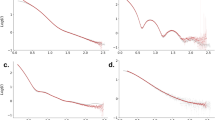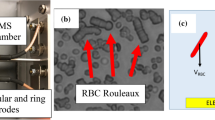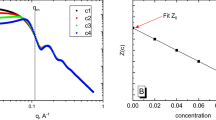Abstract
IN a recent paper, Dervichian, Fournet and Guinier describe experiments on the low-angle scattering of X-rays from red blood cells1. They show that the scattering curve can be explained as being due to the superposition of two intensity distribution curves : one showing a regular decrease from the centre outwards and the other a distinct maximum at 2θ = 0·025 radians, corresponding to a Bragg spacing of 62 A. The authors conclude from the latter that the hæmoglobin molecules in the red cell are not distributed at random, but that a certain mean distance between neighbouring molecules is frequently realized. These results are the more interesting, since the scattering effects observed can be predicted from the molecular dimensions of hæmoglobin and its concentration in the red cell, as will be shown below.
This is a preview of subscription content, access via your institution
Access options
Subscribe to this journal
Receive 51 print issues and online access
$199.00 per year
only $3.90 per issue
Buy this article
- Purchase on Springer Link
- Instant access to full article PDF
Prices may be subject to local taxes which are calculated during checkout
Similar content being viewed by others
References
Dervichian, D. G., Fournet, G., and Guinier, A., C.R. Acad. Sci., Paris, 224, 1848 (1947).
Boyes-Watson, J., Davidson, E., and Perutz, M. F., Proc. Roy. Soc., A, 191, 83 (1947).
Roughton, F. J. W., Amer. J. Physiol., 143, 609 (1945).
Perutz, M. F., Trans. Farad., Soc, 42 B, 187 (1946).
Randall, J. T., "The Diffraction of X-Rays by Amorphous Solids, Liquids and Gases" (London, 1934).
Author information
Authors and Affiliations
Rights and permissions
About this article
Cite this article
PERUTZ, M. Submicroscopic Structure of the Red Cell. Nature 161, 204–205 (1948). https://doi.org/10.1038/161204a0
Issue Date:
DOI: https://doi.org/10.1038/161204a0
This article is cited by
-
Influence of intracellular convection on the oxygen release by human erythrocytes
Pfl�gers Archiv European Journal of Physiology (1972)
-
The diffusion of carbon dioxide in erythrocytes and hemoglobin solutions
Pfl�gers Archiv European Journal of Physiology (1971)
-
Liquid crystals and living systems
Journal of the American Oil Chemists' Society (1968)
-
Die Carrier-Funktion des H�moglobins beim Sauerstoff-Transport im Erythrocyten
Pfl�gers Archiv f�r die Gesamte Physiologie des Menschen und der Tiere (1962)
Comments
By submitting a comment you agree to abide by our Terms and Community Guidelines. If you find something abusive or that does not comply with our terms or guidelines please flag it as inappropriate.



